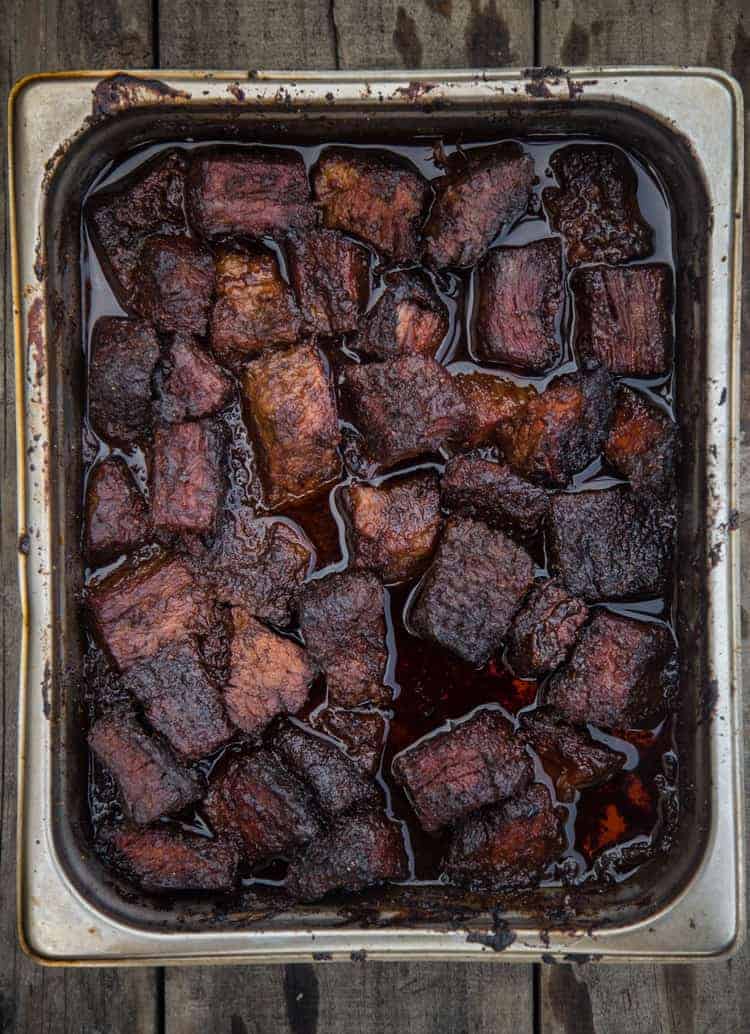Beef Brisket Burnt Ends are one of the ultimate treats in BBQ and a true reward for your hours of hard work in low and slow cooking. Burnt Ends BBQ is like meat candy with soft texture and a sweet and tangy sauce finish. This recipe is for cooking an entire brisket and then portioning some of it (the point) into burnt ends.
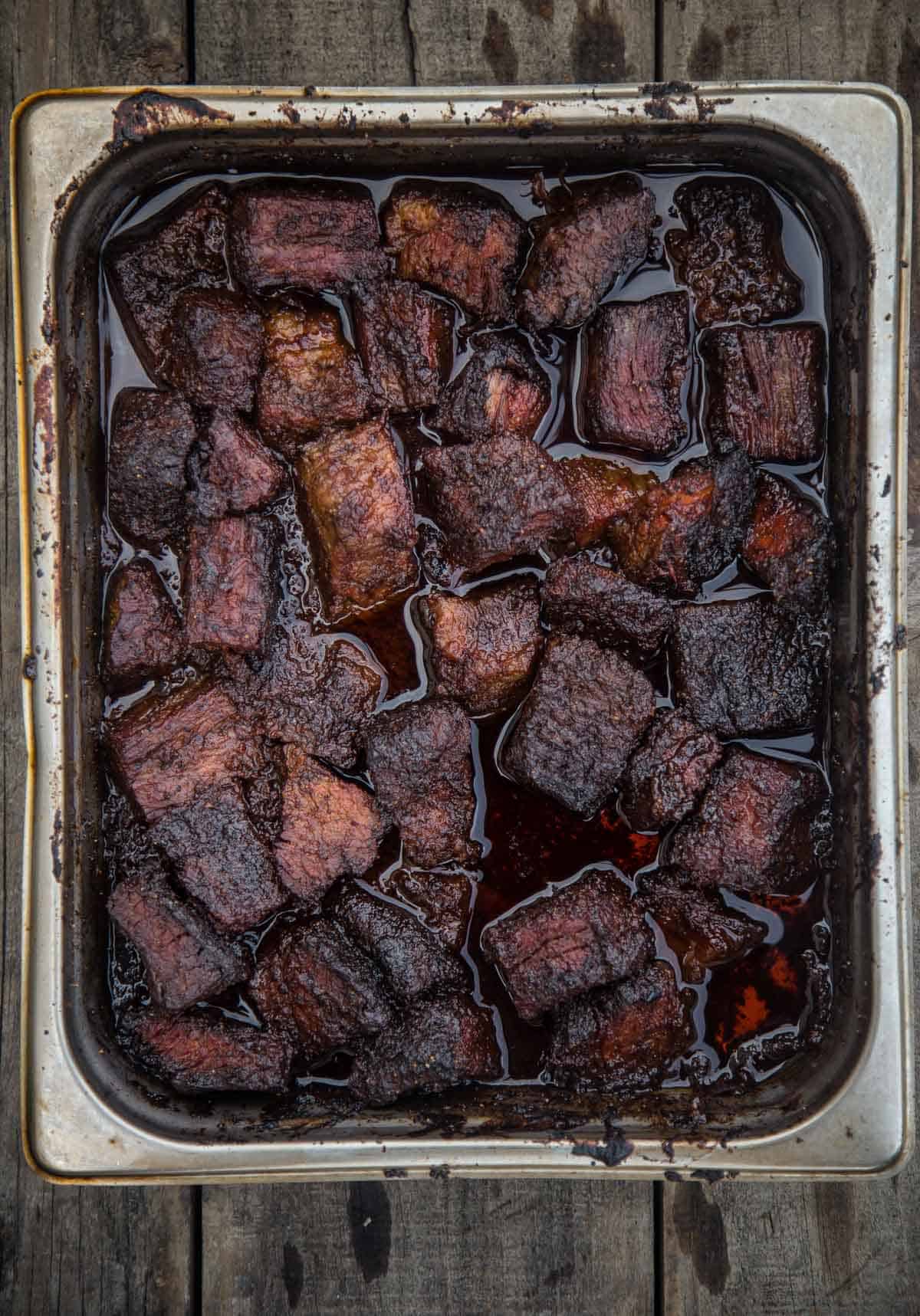
[feast_advanced_jump_to]
Beef Burnt Ends Recipe Highlights
- Use the point muscle, from the brisket, for the most tender style of burnt ends.
- You can make burnt ends from an entire brisket but be sure to separate the point from the flat, after smoking and cutting into cubes.
- Use a Kansas City Style BBQ sauce for a more authentic flavor, however you can modify with any sauce you like.
Understanding a Packer Brisket
There are two muscles on a packer (or whole brisket) called the point and the flat. The point and flat are connected by a layer of fat. The point is well marbled and the best cut for burnt ends. The brisket flat is leaner and best for slices. You can smoke the entire brisket into an amazing meal, but for burnt ends you have to take a few additional steps.
You can call your butcher in advance to see if they will sell just the point. If that is the case, follow this recipe by smoking the point, cutting into cubes, saucing, and finishing in the smoker.
What Are Burnt Ends?
Burnt Ends are cubed up pieces of smoked point meat from the point of the brisket. They are cubed, then sauced, and added back into the smoker to caramelize, rendering a juicy and tender beef bite.
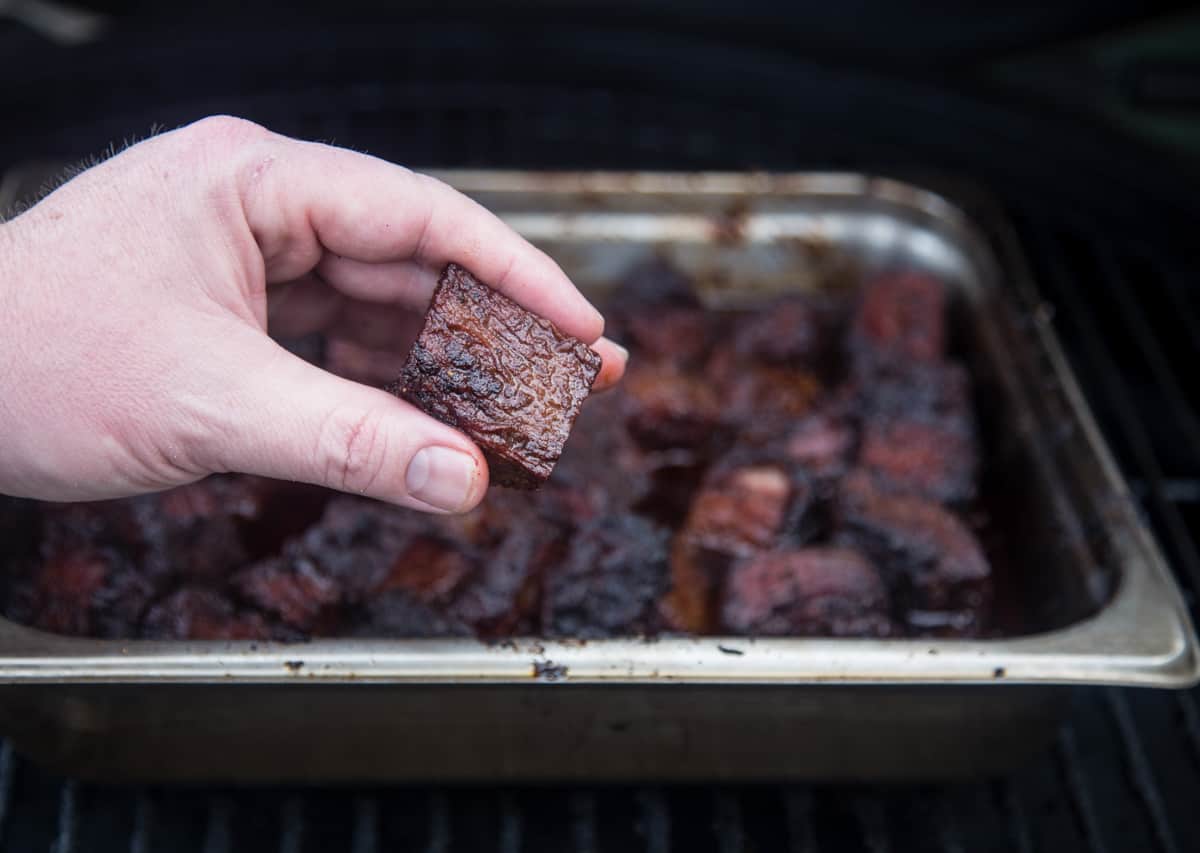
They are said to have originated in Kansas City by a few early BBQ pioneers. Today you can swing by Jack Stack or Joe’s Kansas City (formerly Oklahoma Joe’s) and taste their version of the KC origin story. We are using the entire packer brisket, smoking it, and then separating the point from the flat to make burnt ends. Serve the brisket flat along side of the burnt ends or as the main dish with the burnt ends as the appetizer.
Don’t let the name fool you. Burnt ends are not, in fact, burnt. They are cubed up and have a darker color from the smoke creating bark, and then continue to form more color as they cook in the sauce. The sugar in the sauce caramelizes helped by adding honey, butter, agave nectar, or any other similar ingredient. There are even variations of burnt ends from other meats, like pork belly burnt ends.
How to Make Burnt Ends
- Smoke the brisket. Some may separate the point and just smoke that, which is fine, but we just cook them together all at once.
- Separate the Point and Flat. After the brisket reaches 165 degrees Fahrenheit use a long slicer knife along the fat pocket that is between the point and flat and separate the two muscles.
- Cube the Point. Cut up the point into 1 to 1 ½ inch cubes into a tray, add sauce and honey. Place uncovered back into the smoker for a few more hours.
- Remove from smoker. We typically probe the burnt ends with an instant read thermometer, like the Thermoworks Thermapen, for texture and the general temperature of the burnt ends is 200 – 210 degrees F. They should probe like butter.
Smoke the Whole Brisket
Start by cooking the brisket packer as you would normally, this post highlights the details. Ideal cooking temperature is low, 250 degrees Fahrenheit. We use fruit woods readily available in the Pacific Northwest. We recommend you use your favorite local wood. Typically this runs up to five or six hours until an internal temperature of 165 degrees, measured by a leave in blue tooth thermometer, like the Thermoworks Smoke unit.
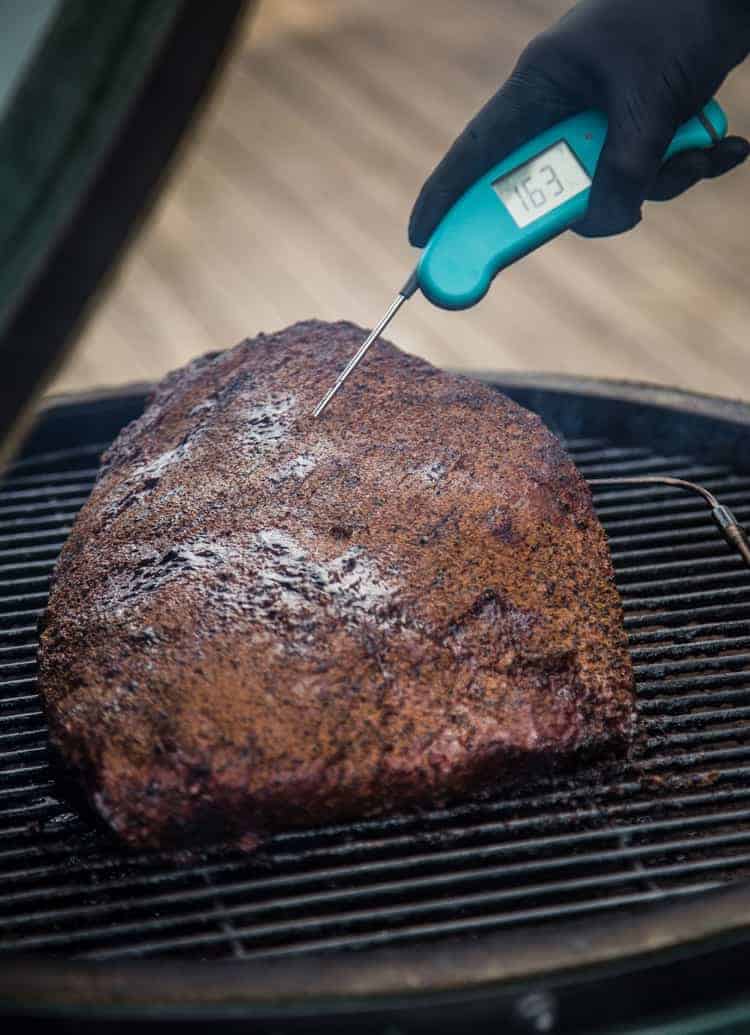
Separate The Point From the Flat
At the time you would normally wrap your whole brisket (when internal temp reaches 165 degrees F), that is when we separate the flat from the point. Trim off some of the fat layer between the point and the flat, and then cut up the point into 1 ½-inch cubes.
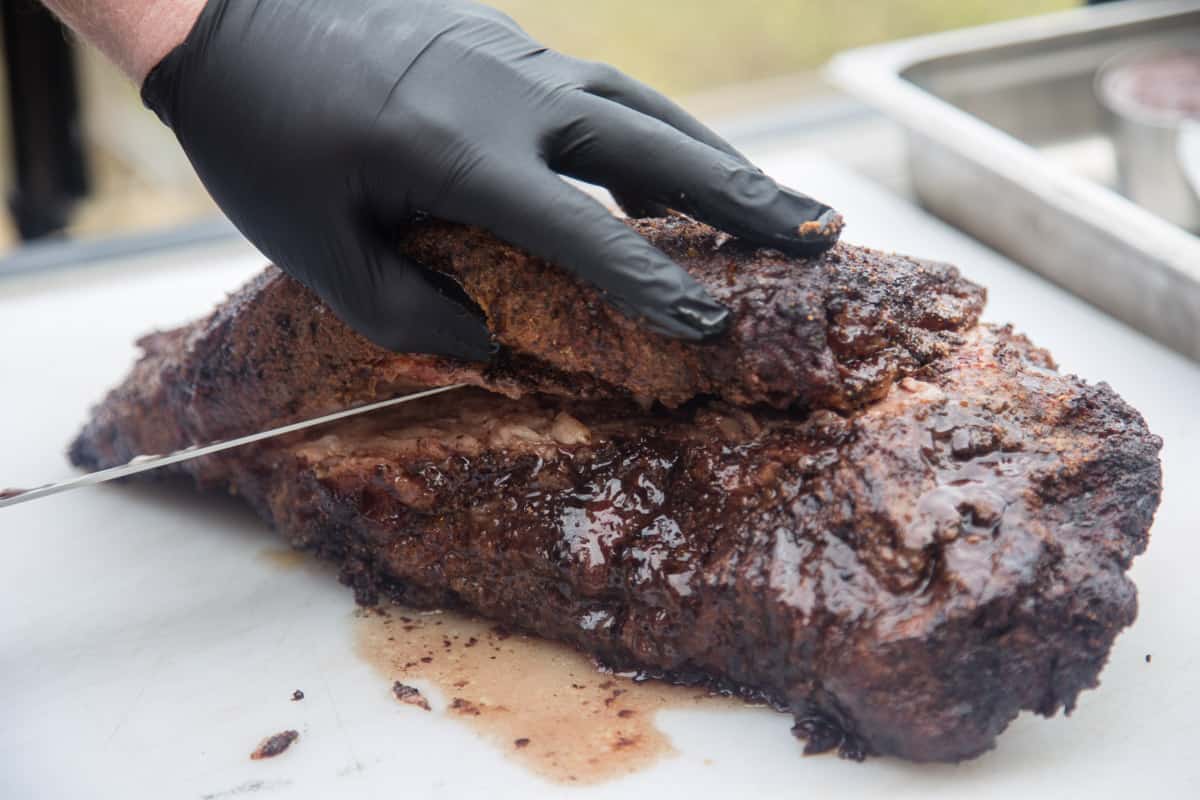
Cook the point cubes and flat separately. The point cubes go into a pan with BBQ sauce, butter, dry rub, and honey, and the flat is then wrapped and then placed back onto the smoker to continue cooking. You can also separate the point before you cook, but for our preferred method we cook the packer and then separate the point from the flat when we wrap.
Flavor and Sauce The Burnt Ends
When placing the burnt ends into the pan, dust with more rub, then add sauce. It’s important to have enough BBQ sauce for the size of the pan you are using. Typically we start with one cup of sauce and add more as needed to make sure the burnt ends are all evenly covered, otherwise the burnt ends will continue to cook unevenly and you’ll have some chewy bites alongside some perfect morsels.
For more flavor add a touch of butter and honey. This adds another punch of flavor and the sugar in the honey help caramelize making great burnt ends bbq.
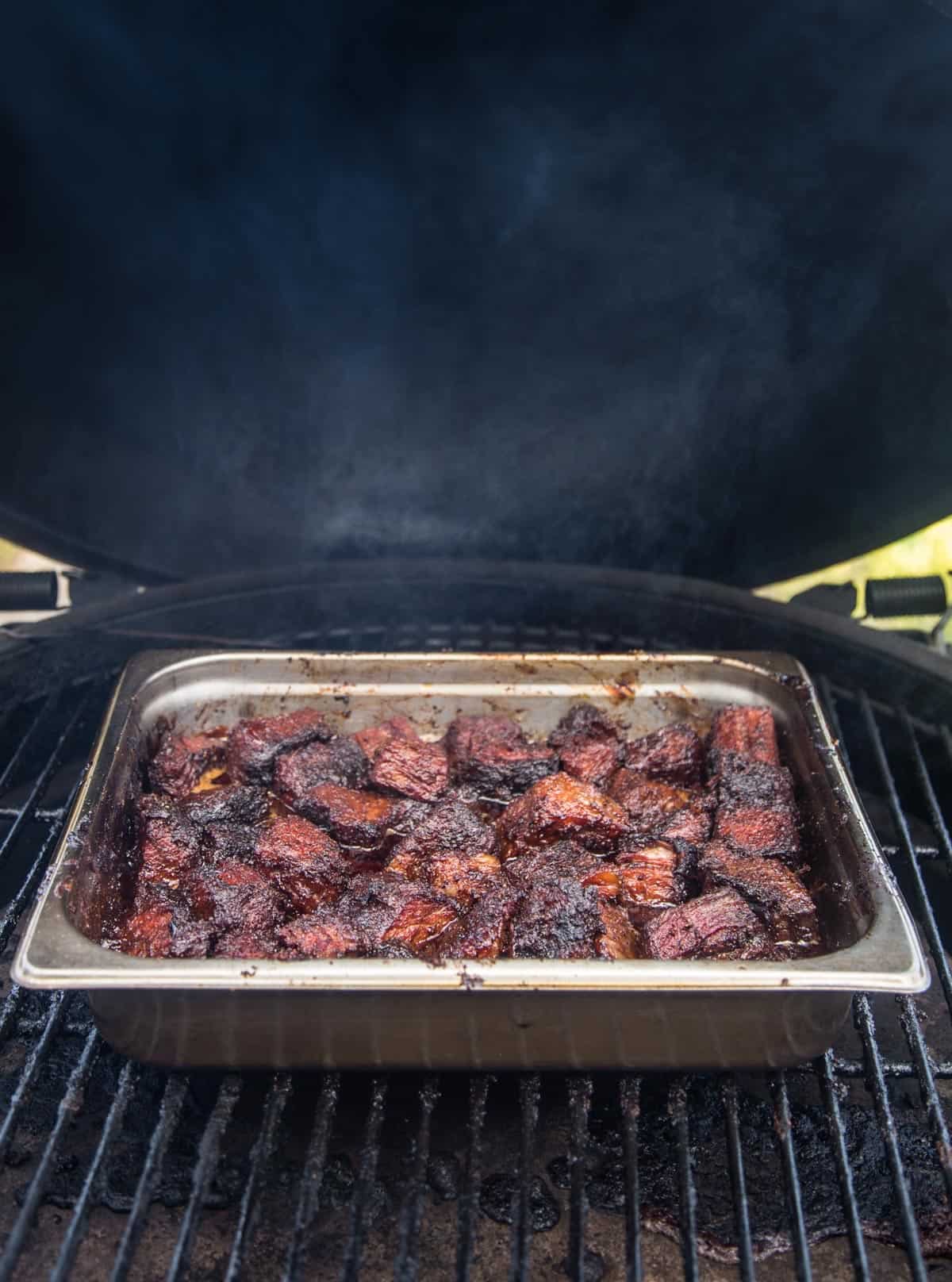
Cook for two more hours uncovered. This allows the fat to render out of the burnt ends, and the sauce will reduce while cooking. After two hours, when the sauce has reduced a bit, cover the pan with foil and return to smoker.
Continue cooking, covered, and check the temperature of the burnt ends 60 minutes later, and pull when the internal temperature of the burnt ends are 200 degrees, or until the meat thermometer inserts like into room temperature butter. This process will take up to 2 additional hours after they are covered in foil. The key is temperature not time. When you get the temperature reading and feeling you like, pull the ends and serve when they slightly cool.
We recommend the Thermoworks Thermapen One when checking the temperature.
The Brisket Flat
Don’t forget about the flat! Continue to smoke like you would a normal brisket. Wrap the flat in butcher paper (or foil), until the temperature of the flat starts reaching 190 degrees. This can take a few more hours. The flat is done when the temperature probe inserts into the flat like butter.
Remove wrapped, and place into a small cooler (with no ice) to let rest for an hour. Remove, slice, and serve for the main dish.
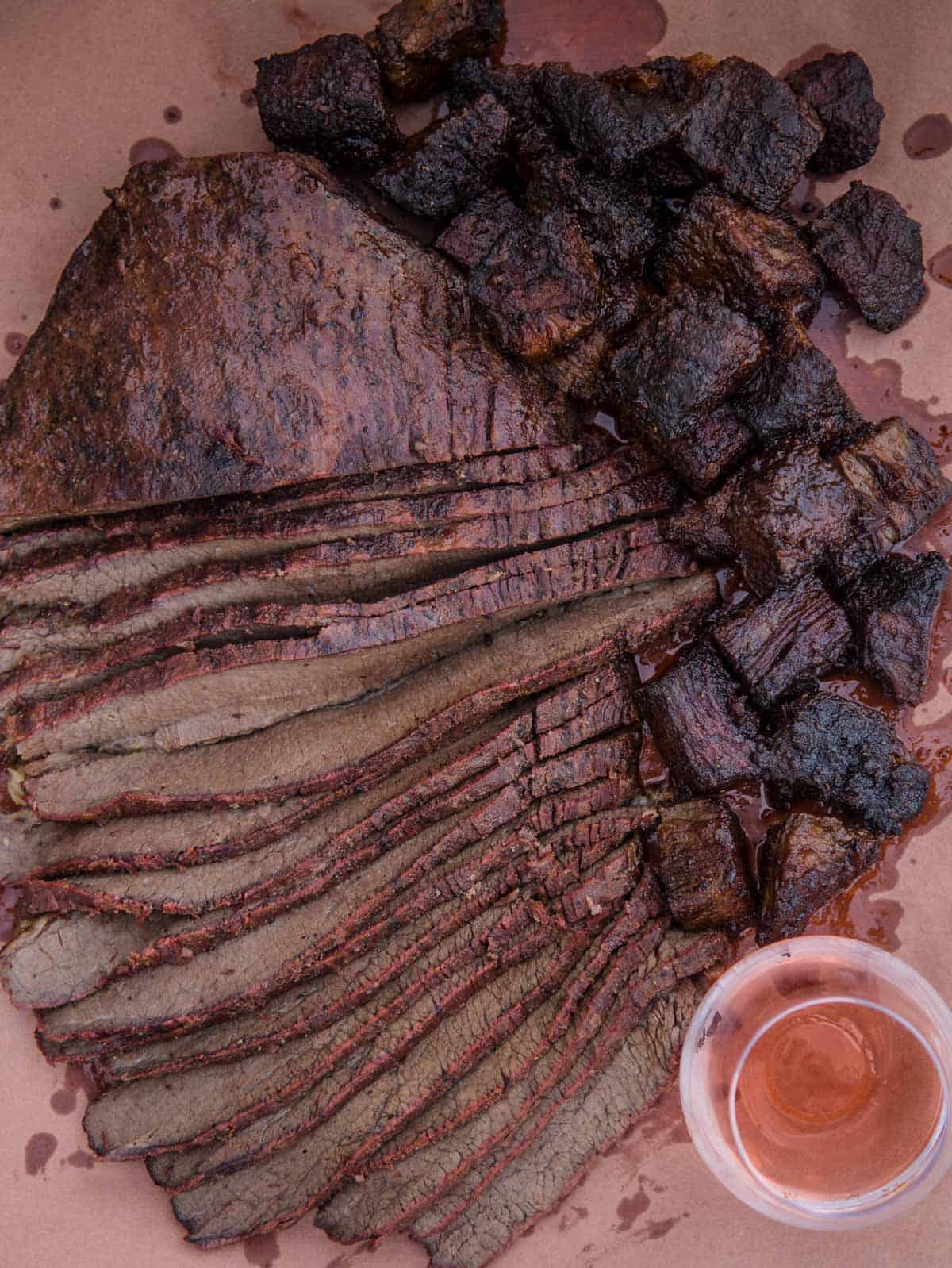
Wine Pairing For Brisket and Burnt Ends BBQ
You may be surprised to know our favorite go to for this recipe is rosé wine. This is because of the smoky beefy flavor, and sauce, a nice dry rosé complements the flavor of the brisket. Buy a bold Washington State rosé, which tends to be made from merlot, or bigger red blends. Or go with a nice dry sparkling wine.
Frequently Asked Questions
The point is the best portion of the brisket for burnt ends. It has more marbling than the flat which renders into better cubes of flavor.
Yes, if you follow the right steps, they will be very tender. The best way to achieve that is by smoking for a few hours, then slicing up the point into cubes, saucing, and continuing to smoke them until they are ready. The tenderness comes when the intramuscular fat all renders out and usually occurs when the internal temperature of the point cubes is 190 – 200 degrees F.
It is not recommended to make burnt ends from the flat. It is much leaner, and as it cooks to a higher temperature runs the risk of falling apart. We recommend using the point muscle or something like chuck roast (beef shoulder), often referred to as poor mans burnt ends.
Using the point muscle and a good slicer knife, cut the point into 1-inch cubes.
This post was originally published in April 2019, and updated in April 2022 wit updated details. The recipe remains the same.
This post may contain affiliate links. This means if you click on the link, we may receive a small commission if you purchase through the link. We partner with brands we know and love and use and it helps keep the blog going!
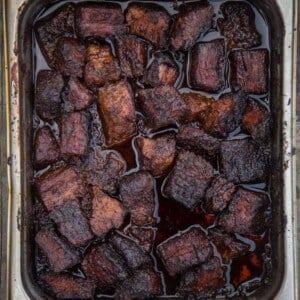
Brisket Burnt Ends Recipe
#wprm-recipe-user-rating-0 .wprm-rating-star.wprm-rating-star-full svg * { fill: #ffffff; }#wprm-recipe-user-rating-0 .wprm-rating-star.wprm-rating-star-33 svg * { fill: url(#wprm-recipe-user-rating-0-33); }#wprm-recipe-user-rating-0 .wprm-rating-star.wprm-rating-star-50 svg * { fill: url(#wprm-recipe-user-rating-0-50); }#wprm-recipe-user-rating-0 .wprm-rating-star.wprm-rating-star-66 svg * { fill: url(#wprm-recipe-user-rating-0-66); }linearGradient#wprm-recipe-user-rating-0-33 stop { stop-color: #ffffff; }linearGradient#wprm-recipe-user-rating-0-50 stop { stop-color: #ffffff; }linearGradient#wprm-recipe-user-rating-0-66 stop { stop-color: #ffffff; }
Ingredients
- 1 12 to 14 pound packer brisket, (We use Snake River Farms)
- ⅓ cup extra virgin olive oil
- ⅓ cup kosher salt
- ⅓ cup coarse ground pepper
- ⅓ cup granulated garlic
- 1 cup KC barbecue sauce (We used our KC Style sauce)
- 4 tablespoons unsalted butter
- ¼ cup honey
Instructions
-
Prep Brisket: The day prior to smoking the brisket, trim it. Using a sharp knife, remove excess layers of fat and silver skin.
-
Season Brisket: Coat the brisket with olive oil and then combine the dry rub ingredients in a bowl. Reserve ⅓ of a cup of the rub for the burnt ends later in the cooking process. Liberally season the brisket with the dry rub. Don’t be shy. Wrap in foil and place in fridge over night, until ready to cook.
-
Preheat Smoker: to 250 degrees F using apple or cherry wood. Remove the brisket from the fridge at this point. When smoker is at temp, insert your meat thermometer into the flat and place in smoker. We place ours fat cap side down, as the bottom of our smoker is hotter than the top.
-
Smoke Brisket: Smoke until the brisket reaches an internal temperature of 165 degrees F. Remove from smoker and then, using a sharp knife, remove the point from the flat. Trim some of the excess fat off point and the flat.
For the Brisket Flat
-
Wrap the flat in peach butcher paper, and then re-insert the meat thermometer. Place back in smoker and continue to cook until the internal temperature of the brisket flat reaches 190 degrees. Begin temping the flat in various places, and remove from smoker when the temperature probe inserts easily into the flat like butter. This can take 3 to 5 additional hours depending on size of brisket.
-
Place wrapped brisket flat in a cooler with no ice and let rest for an hour. Remove and then slice against the grain.
For the Burnt Ends
-
After placing the flat back into the smoker, cut the point into 1 ½-inch cubes. Place them into a smoker safe tray. Season with the reserved ⅓ cup of dry rub, and then add barbecue sauce, butter and honey, and toss together. Place uncovered in the smoker and stir once the butter and honey have melted.
-
Smoke in the tray uncovered for 2 hours. Stir midway to incorporate the sauce and move the cubes around. After 2 hours cover with foil and place back into the smoker. Remove when the internal temperature ranges from 190 to 205, or when the meat thermometer inserts into the cube like butter (expect an additional 1 or 2 hours).
-
Serve immediately.
Notes
Find the perfect wine pairing at the Vindulge Wine Shop
Nutrition
The post The Ultimate Brisket Burnt Ends appeared first on Vindulge.


